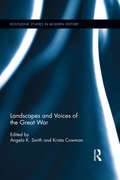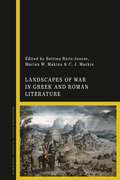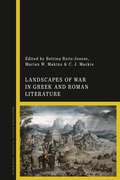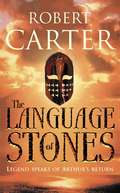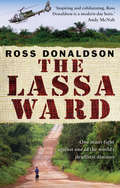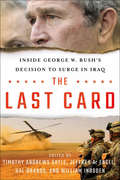- Table View
- List View
Landscapes and Voices of the Great War (Routledge Studies in Modern History #22)
by Angela K. Smith Krista CowmanThis volume aims to provide a wider view of First World War experience through focusing on landscapes less commonly considered in historiography, and on voices that have remained on the margins of popular understanding of the war. The landscape of the western front was captured during the conflict in many different ways: in photographs, paintings and print. The most commonly replicated voicing of contemporary attitudes towards the war is that of initial enthusiasm giving way to disillusionment and a sense of overwhelming futility. Investigations of the many components of war experience drawn from social and cultural history have looked to landscapes and voices beyond the frontline as a means of foregrounding different perspectives on the war. Not all of the voices presented here opposed the war, and not all of the landscapes were comprised of trenches or flanked by barbed wire. Collectively, they combine to offer further fresh insights into the multiplicity of war experience, an alternate space to the familiar tropes of mud and mayhem.
Landscapes and Voices of the Great War (Routledge Studies in Modern History #22)
by Angela K. Smith Krista CowmanThis volume aims to provide a wider view of First World War experience through focusing on landscapes less commonly considered in historiography, and on voices that have remained on the margins of popular understanding of the war. The landscape of the western front was captured during the conflict in many different ways: in photographs, paintings and print. The most commonly replicated voicing of contemporary attitudes towards the war is that of initial enthusiasm giving way to disillusionment and a sense of overwhelming futility. Investigations of the many components of war experience drawn from social and cultural history have looked to landscapes and voices beyond the frontline as a means of foregrounding different perspectives on the war. Not all of the voices presented here opposed the war, and not all of the landscapes were comprised of trenches or flanked by barbed wire. Collectively, they combine to offer further fresh insights into the multiplicity of war experience, an alternate space to the familiar tropes of mud and mayhem.
Landscapes of the First World War
by Vanda Wilcox Selena Daly Martina SalvanteThis comparative and transnational study of landscapes in the First World War offers new perspectives on the ways in which landscapes were idealised, mobilised, interpreted, exploited, transformed and destroyed by the conflict. The collection focuses on four themes: environment and climate, industrial and urban landscapes, cross-cultural encounters, and legacies of the war. The chapters cover Europe, Russia, the Middle East, Africa and the US, drawing on a range of approaches including battlefield archaeology, military history, medical humanities, architecture, literary analysis and environmental history. This volume explores the environmental impact of the war on diverse landscapes and how landscapes shaped soldiers’ experiences at the front. It investigates how rural and urban locales were mobilised to cater to the demands of industry and agriculture. The enduring physical scars and the role of landscape as a crucial locus of memory and commemoration are also analysed. The chapter 'The Long Carry: Landscapes and the Shaping of British Medical Masculinities in the First World War' is open access under a CC BY 4.0 license via link.springer.com.
Landscapes of Trauma: The Psychology of the Battlefield
by Nigel HuntIntegrating trauma studies with historical research and social psychology, Landscapes of Trauma examines a range of battlefields from across history, including Waterloo, the Battle of Sedan, the Battle of the Ebro and the Battle of Normandy, to bring to light what these battlefields say about our collective and individual psyches. Hunt explores how war shapes the nature of trauma, not only by its innate horror but also by the historical and societal contexts it is fought in, from the cultural and social conventions of the period to the topography of the settings. This book provides a deep analysis of how war is experienced and remembered in different eras and by different generations. Moving beyond the clinical concept of post-traumatic stress disorder, Hunt discusses how trauma can be understood socially and historically, as well as through the lens of individual suffering. This book also investigates the psychological foundations of memorialisation, remembrance and commemoration that shape the legacy of the battles discussed. Using interviews with veterans, their letters, journals and diaries, as well as literary and historical sources, Hunt locates the battlefield as a place where humans explore the parameters of human behaviour, thought and emotion. This book is in important resource for students and scholars interested in the psychology of trauma and war, as well as military history.
Landscapes of Trauma: The Psychology of the Battlefield
by Nigel HuntIntegrating trauma studies with historical research and social psychology, Landscapes of Trauma examines a range of battlefields from across history, including Waterloo, the Battle of Sedan, the Battle of the Ebro and the Battle of Normandy, to bring to light what these battlefields say about our collective and individual psyches. Hunt explores how war shapes the nature of trauma, not only by its innate horror but also by the historical and societal contexts it is fought in, from the cultural and social conventions of the period to the topography of the settings. This book provides a deep analysis of how war is experienced and remembered in different eras and by different generations. Moving beyond the clinical concept of post-traumatic stress disorder, Hunt discusses how trauma can be understood socially and historically, as well as through the lens of individual suffering. This book also investigates the psychological foundations of memorialisation, remembrance and commemoration that shape the legacy of the battles discussed. Using interviews with veterans, their letters, journals and diaries, as well as literary and historical sources, Hunt locates the battlefield as a place where humans explore the parameters of human behaviour, thought and emotion. This book is in important resource for students and scholars interested in the psychology of trauma and war, as well as military history.
Landscapes of War in Greek and Roman Literature
by Bettina Reitz-Joosse, Marian W. Makins, C. J. MackieIn this volume, literary scholars and ancient historians from across the globe investigate the creation, manipulation and representation of ancient war landscapes in literature. Landscape can spark armed conflict, dictate its progress and influence the affective experience of its participants. At the same time, warfare transforms landscapes, both physically and in the way in which they are later perceived and experienced. Landscapes of War in Greek and Roman Literature breaks new ground in exploring Greco-Roman literary responses to this complex interrelationship. Drawing on current ideas in cognitive theory, memory studies, ecocriticism and other fields, its individual chapters engage with such questions as: how did the Greeks and Romans represent the effects of war on the natural world? What distinctions did they see between spaces of war and other landscapes? How did they encode different experiences of war in literary representations of landscape? How was memory tied to landscape in wartime or its aftermath? And in what ways did ancient war landscapes shape modern experiences and representations of war? In four sections, contributors explore combatants' perception and experience of war landscapes, the relationship between war and the natural world, symbolic and actual forms of territorial control in a military context, and war landscapes as spaces of memory. Several contributions focus especially on modern intersections of war, landscape and the classical past.
Landscapes of War in Greek and Roman Literature
In this volume, literary scholars and ancient historians from across the globe investigate the creation, manipulation and representation of ancient war landscapes in literature. Landscape can spark armed conflict, dictate its progress and influence the affective experience of its participants. At the same time, warfare transforms landscapes, both physically and in the way in which they are later perceived and experienced. Landscapes of War in Greek and Roman Literature breaks new ground in exploring Greco-Roman literary responses to this complex interrelationship. Drawing on current ideas in cognitive theory, memory studies, ecocriticism and other fields, its individual chapters engage with such questions as: how did the Greeks and Romans represent the effects of war on the natural world? What distinctions did they see between spaces of war and other landscapes? How did they encode different experiences of war in literary representations of landscape? How was memory tied to landscape in wartime or its aftermath? And in what ways did ancient war landscapes shape modern experiences and representations of war? In four sections, contributors explore combatants' perception and experience of war landscapes, the relationship between war and the natural world, symbolic and actual forms of territorial control in a military context, and war landscapes as spaces of memory. Several contributions focus especially on modern intersections of war, landscape and the classical past.
Language and Revolution: Making Modern Political Identities (Cummings Center Series #Vol. 16)
by Igal HalfinThis work examines the role of language in forging the modern subject. Focusing on the idea of the "New Man" that has animated all revolutionaries, the present volume asks what it meant to define oneself in terms of one's class origins, gender, national belonging or racial origins.
Language and Revolution: Making Modern Political Identities (Cummings Center Series)
by Igal HalfinThis work examines the role of language in forging the modern subject. Focusing on the idea of the "New Man" that has animated all revolutionaries, the present volume asks what it meant to define oneself in terms of one's class origins, gender, national belonging or racial origins.
The Language of Stones (The\language Of Stones Ser. #Bk. 2)
by Robert CarterA rich and evocative tale set in a mythic 15th century Britain, to rival the work of Bernard Cornwell.
The Language of War
by Oleksandr MykhedWhen everyday life becomes a state of emergency, how can yesterday’s words suffice?‘We were so happy and didn’t know it…’A thirty-three-year-old writer lives in a quiet European suburb with his wife and his dog. His parents have bought an apartment nearby. On weekends they go out for brunch, cook and see friends. Life is good; it is normal. Then the invaders come.The Language of War is about what happens when your world changes overnight. When you wake up to the sound of helicopters and the smell of gunpowder. When your home is hit by shells or broken into by gunmen, and you spend another night in a basement-turned-bomb shelter. When, even though you’ve never held a weapon before, you realise the only choice is to fight back. It is about things one can never forget, or forgive.Bringing together Oleksandr Mykhed’s vivid day-by-day chronicles of the invasion of Ukraine with a chorus of other voices – his family, friends in exile, those who have fought and have witnessed unimaginable atrocities – this book is both a record, and a reckoning. Haunting and timeless, it asks how it is possible to find the words to describe a new reality; how you can still make sense of the world when the only language you can speak is the language of war.
Languages and the First World War: Representation and Memory (Palgrave Studies in Languages at War)
by Julian Walker Christophe DeclercqWith several terms from the First World War still present in modern speech, Languages and the First World War presents over 30 essays by international academics investigating the linguistic aspects of the 1914-18 conflict. The first of the two volumes covers language change and documentation during the period of the war, while the second examines the representation and the memory of the war. Communicating in a Transnational War examines languages at the front, including the subject of interpretation, translation and parallels between languages; communication with the home front; propaganda and language manipulation; and recording language during the war. Representation and Memory examines historiographical issues; the nature of representing the war in letters and diaries; the documentation of language change; the language of representing the war in reportage and literature; and the language of remembering the war. Covered in the process are slang, censorship, soldiers' phrasebooks, code-switching, borrowing terms, the problems facing multilingual armies, and gendered language.
Languages and the Military: Alliances, Occupation and Peace Building (Palgrave Studies in Languages at War)
by Hilary Footitt and Michael KellyThrough detailed case studies ranging from the 18th century until today,this book explores the role of foreign languages in military alliances, in occupation and in peace building. It brings together academic researchers and practitioners from the museum and interpreting worlds and the military.
The Lassa Ward: One Man's Fight Against One Of The World's Deadliest Diseases
by Ross DonaldsonIn the summer of 2003, a perilous helicopter descent delivered Ross Donaldson, an American medical student in his twenties, into Sierra Leone. With abundant schooling but little practical experience, Ross wanted to save the world. Little did he know that by the end of his journey, it would be he who would need rescue.With rebels fighting just across the border in Liberia, humanitarian need quickly swept Ross southward towards makeshift refugee camps and the heart of danger. There, he had his first terrifying encounter with the highly contagious Lassa Virus. Working on the Lassa Fever Ward, he was wholly unprepared for what he would find, and for twist of fate that saw him running the facility alone, with only a handful of untrained nurses to help him.Based on his personal journal, this gripping memoir details the time Ross spent on the Lassa Ward, and his own battle with a potentially fatal illness. It is a real-life thriller that not only tells the adventure-packed tale of a modern-day hero, but also bears witness to a people in need, and the struggle of those who risk their daily comforts, and even their lives, to help them.
The Last Battle: When U.S. and German Soldiers Joined Forces in the Waning Hours of World War II in Europe
by Stephen HardingThe incredible story of the unlikeliest battle of World War II, when a small group of American soldiers joined forces with German soldiers to fight off fanatical SS troopsMay, 1945. Hitler is dead, the Third Reich is little more than smoking rubble, and no GI wants to be the last man killed in action against the Nazis.The Last Battle tells the nearly unbelievable story of the unlikeliest battle of the war, when a small group of American tankers, led by Captain Lee, joined forces with German soldiers to fight off fanatical SS troops seeking to capture Castle Itter and execute the stronghold's VIP prisoners. It is a tale of unlikely allies, startling bravery, jittery suspense, and desperate combat between implacable enemies.
The Last Battle: Victory, Defeat, and the End of World War I
by Peter HartAuthor of The Great War, as well as celebrated accounts of the battles of the Somme, Passchendaele, Jutland, and Gallipoli, historian Peter Hart now turns to World War One's final months. Much has been made of-and written about-August 1914. There has been comparatively little focus on August 1918 and the lead-up to November. Because of the fixation on the Great War's opening moves, and the great battles that followed over the course of the next four years, the endgame seems to come as a stunning anticlimax. At the eleventh hour of the eleventh day of the eleventh month of 1918 the guns simply fell silent. The Last Battle definitively corrects this misperception. As Hart shows, a number of factors precipitated the Armistice. After four years of bloodshed, Germany was nearly bankrupt and there was a growing rift between the military High Command and political leadership. But it also remained a determined combatant, and France and Great Britain had equally been stretched to their limits; Russia had abandoned the conflict in the late winter of 1918. However complex the causes of Germany's ultimate defeat, Allied success on the Western Front, as Hart reveals, tipped the scales-the triumphs at the Fifth Battle of Ypres, the Sambre, the Selle, and the Meuse-Argonne, where American forces made arguably their greatest contribution. The offensives cracked the Hindenburg Line and wore down the German resistance, precipitating collapse. Final victory came at great human cost and involved the combined efforts of millions of men. Using the testimony of a range of participants, from the Doughboys, Tommies, German infantrymen, and French poilus who did the fighting, to those in command during those last days and weeks, Hart brings intimacy and sweep to the events that led to November 11, 1918.
The Last Battle: The Classic History Of The Battle For Berlin
by Cornelius RyanThe Battle for Berlin was the final struggle of World War II in the European theatre, the last offensive against Hitler's Third Reich, which devastated one of Europe's historic capitals and brought an end to the Nazi regime. It lasted more than two weeks across April -- May 1945, and was one of the bloodiest and most pivotal episodes of the war, one which would play a part in determining the shape of international politics for decades to come. THE LAST BATTLE is a story of brutal extremes, of stunning military triumph alongside the stark conditions that the civilians of Berlin experienced in the face of the Allied assault. It is history at its best, a masterful illumination of the effects of war on the lives of individuals, and one of the enduring works on World War II.
The Last Battle on English Soil, Preston 1715
by Jonathan OatesWhilst much has been written about the Jacobites, most works have tended to look at the Rebellion of 1745, rather than the earlier attempt to reinstate the Stuart dynasty. As such this book provides a welcome focus on events in 1715, when Jacobites in both England and Scotland tried to oust George I and to replace him with James Stuart. In particular it provides a detailed narrative and analysis of the campaign in the Lowlands of Scotland and in the north of England that led to the decisive battle at Preston and ended the immediate prospects of the Jacobite cause. Drawing upon a wealth of under-utilised sources, the work builds on existing research into the period to give weight to the community and individual dimensions of the crisis as well as to the military ones. Contrary to popular myth, the Jacobite army contained both English and Scots, and because it surrendered almost intact, an analysis of the surviving list of Jacobite prisoners captured in the North West England reveals much information about their origins, occupations, unit structure and, sometimes, religion, as well as the quality of the soldiers’ arms and equipment, their experience and that of their leaders. Through this study of the last major battle to be fought on English soil, a clearer picture emerges of the individuals and groups who sought to mould the direction of the freshly created British state and the dynasty that should rule it.
The Last Battle on English Soil, Preston 1715
by Jonathan OatesWhilst much has been written about the Jacobites, most works have tended to look at the Rebellion of 1745, rather than the earlier attempt to reinstate the Stuart dynasty. As such this book provides a welcome focus on events in 1715, when Jacobites in both England and Scotland tried to oust George I and to replace him with James Stuart. In particular it provides a detailed narrative and analysis of the campaign in the Lowlands of Scotland and in the north of England that led to the decisive battle at Preston and ended the immediate prospects of the Jacobite cause. Drawing upon a wealth of under-utilised sources, the work builds on existing research into the period to give weight to the community and individual dimensions of the crisis as well as to the military ones. Contrary to popular myth, the Jacobite army contained both English and Scots, and because it surrendered almost intact, an analysis of the surviving list of Jacobite prisoners captured in the North West England reveals much information about their origins, occupations, unit structure and, sometimes, religion, as well as the quality of the soldiers’ arms and equipment, their experience and that of their leaders. Through this study of the last major battle to be fought on English soil, a clearer picture emerges of the individuals and groups who sought to mould the direction of the freshly created British state and the dynasty that should rule it.
The Last Boarding Party: The USMC and the SS Mayaguez 1975 (Raid #24)
by Clayton K. ChunJust two weeks after the close of the Vietnam War, communist Cambodian Khmer Rouge elements seized the S.S. Mayaguez in international waters. Believing they had to act quickly, United States Marines boarded the ship, only to find the crew had been removed. They then launched an assault on a nearby island where they believed the crew had been taken. Instead of a quick strike against a limited foe, the Marines encountered major opposition and were quickly pinned down. With large numbers of Cambodians closing in all around, the a desperate firefight developed as US forces tried to extract the Marines. This book recounts the bloody struggle on Koh Tang island, as a badly botched hostage rescue turned into a desperate evacuation.
The Last Boarding Party: The USMC and the SS Mayaguez 1975 (Raid)
by Steve Noon Clayton Chun Mariusz Kozik Alan GillilandJust two weeks after the close of the Vietnam War, communist Cambodian Khmer Rouge elements seized the S.S. Mayaguez in international waters. Believing they had to act quickly, United States Marines boarded the ship, only to find the crew had been removed. They then launched an assault on a nearby island where they believed the crew had been taken. Instead of a quick strike against a limited foe, the Marines encountered major opposition and were quickly pinned down. With large numbers of Cambodians closing in all around, the a desperate firefight developed as US forces tried to extract the Marines. This book recounts the bloody struggle on Koh Tang island, as a badly botched hostage rescue turned into a desperate evacuation.
The Last Camellia
by Sarah Jio'I adore Sarah Jio's novels.' Santa MontefioreA haunting story of love, family and the secrets that can destroy us... 1933. Vera Ray kisses her young son goodnight and leaves to work the night-shift at a local hotel. The next morning, she discovers an sudden snowfall has blanketed the city, and her son has vanished, the snow covering up any trace of his tracks, or the perpetrator's.2010. Journalist Claire Aldridge has been burying herself in work to avoid her own pain. When she is assigned to cover the 'blackberry winter' storm she learns of the disappearance of a three-year-old boy. He was never found. Claire vows to find the truth, but as she immerses herself in the mysteries of the past, Claire discovers that not all secrets should be revealed.An emotional story of a mother's love, a missing child and the search for the truth. Perfect for fans of Kathryn Hughes, Lucinda Riley and Tracy Rees.
The Last Card: Inside George W. Bush's Decision to Surge in Iraq
This is the real story of how George W. Bush came to double-down on Iraq in the highest stakes gamble of his entire presidency. Drawing on extensive interviews with nearly thirty senior officials, including President Bush himself, The Last Card offers an unprecedented look into the process by which Bush overruled much of the military leadership and many of his trusted advisors, and authorized the deployment of roughly 30,000 additional troops to the warzone in a bid to save Iraq from collapse in 2007.The adoption of a new counterinsurgency strategy and surge of new troops into Iraq altered the American posture in the Middle East for a decade to come. In The Last Card we have access to the deliberations among the decision-makers on Bush's national security team as they embarked on that course. In their own words, President George W. Bush, Vice President Dick Cheney, National Security Advisor Stephen Hadley, Secretary of State Condoleezza Rice, White House Chief of Staff Joshua Bolten, Secretary of Defense Robert Gates, and others, recount the debates and disputes that informed the process as President Bush weighed the historical lessons of Vietnam against the perceived strategic imperatives in the Middle East. For a president who had earlier vowed never to dictate military strategy to generals, the deliberations in the Oval Office and Situation Room in 2006 constituted a trying and fateful moment.Even a president at war is bound by rules of consensus and limited by the risk of constitutional crisis. What is to be achieved in the warzone must also be possible in Washington, D.C. Bush risked losing public esteem and courted political ruin by refusing to disengage from the costly war in Iraq. The Last Card is a portrait of leadership—firm and daring if flawed—in the Bush White House.The personal perspectives from men and women who served at the White House, Foggy Bottom, the Pentagon, and in Baghdad, are complemented by critical assessments written by leading scholars in the field of international security. Taken together, the candid interviews and probing essays are a first draft of the history of the surge and new chapter in the history of the American presidency.
The Last Charge of the Australian Light Horse: From the Australian bush to the Battle of Beersheba - an epic story of courage, resilience and derring-do
by Peter FitzSimonsOn 31st October 1917, as the day's light faded, the Australian Light Horse charged against their enemy. Eight hundred men and horses galloped four miles across open country, towards the artillery, rifles and machine guns of the Turks occupying the seemingly unassailable town of Beersheba. What happened in the next hour changed the course of history.This brave battle and the extraordinary adventures that led to it are brought vividly to life by Australia's greatest storyteller, Peter FitzSimons. It is an epic tale of farm boys, drovers, bank clerks, dentists, poets and scoundrels transported to fight a war half a world away, and is full of incredible characters: from Major Banjo Paterson to Lawrence of Arabia; the brilliant writer Trooper Ion Idriess and the humble General Harry Chauvel; the tearaway Test fast bowler 'Tibby' Cotter and the infamous warhorse, Bill the Bastard. All have their part to play in the enthralling, sprawling drama of the Australian Light Horse.Theirs was a war fought in an ancient land with modern weapons; where the men of the Light Horse were trained in sight of the pyramids, drank in the brothels of Cairo and fought through lands known to them only as names from the Bible.The Last Charge of the Australian Light Horse traces the hard path of the Light Horse from the bleakest of starts - being deprived of their horses and fighting at Gallipoli in the tragic Battle of the Nek - to triumph and glory in the desert. Revealing the feats of the Australians who built the legend, it is a brilliantly told tale of courage, resilience and derring-do from Australia's favourite storyteller.
Last Citadel: A Novel Of The Battle Of Kursk
by David L. RobbinsThe riveting new military novel from the bestselling author of WAR OF THE RATSAfter the cataclysmic fall of Stalingrad, Germany's campaign in Russia stood on a knife's edge. Hitler had to break Russia quickly or the war would be over. Thus 'Operation Citadel' was conceived. This was a plan to eliminate the huge salient around the Russian city of Kursk and trap the enormous Soviet Army in a noose of German steel. The only trouble was that the Russians knew it was coming... A powerful look into the maelstrom of the greatest battle in history, LAST CITADEL follows the story through the eyes of a remarkable group of people - the men and women who fought for family, pride, country and, finally, for survival . . .
